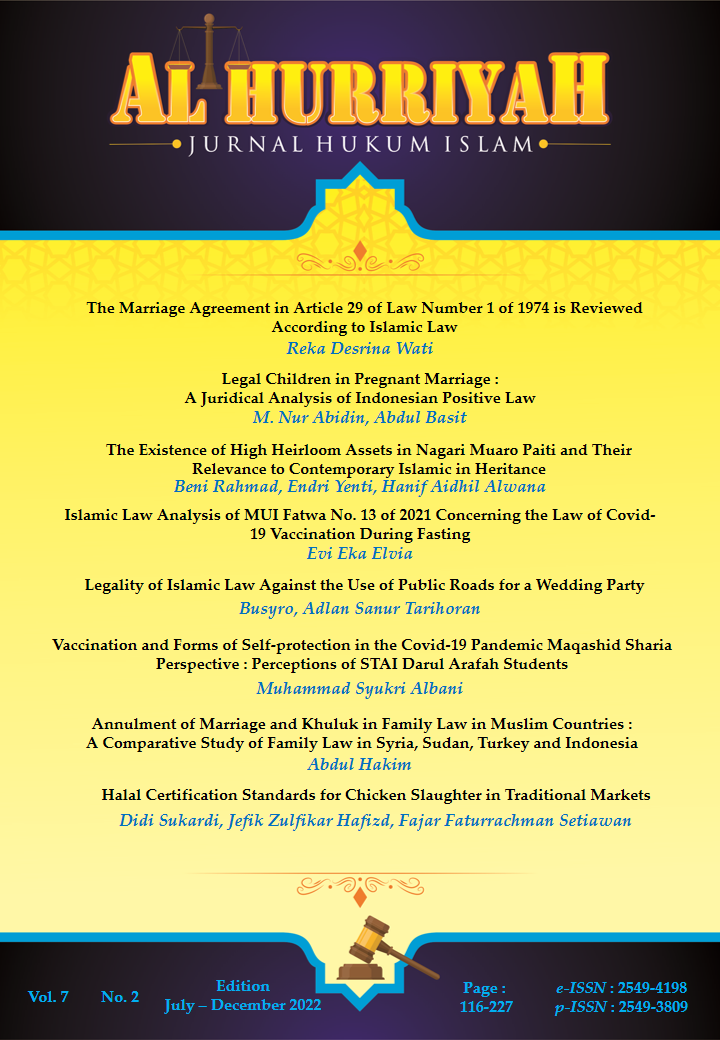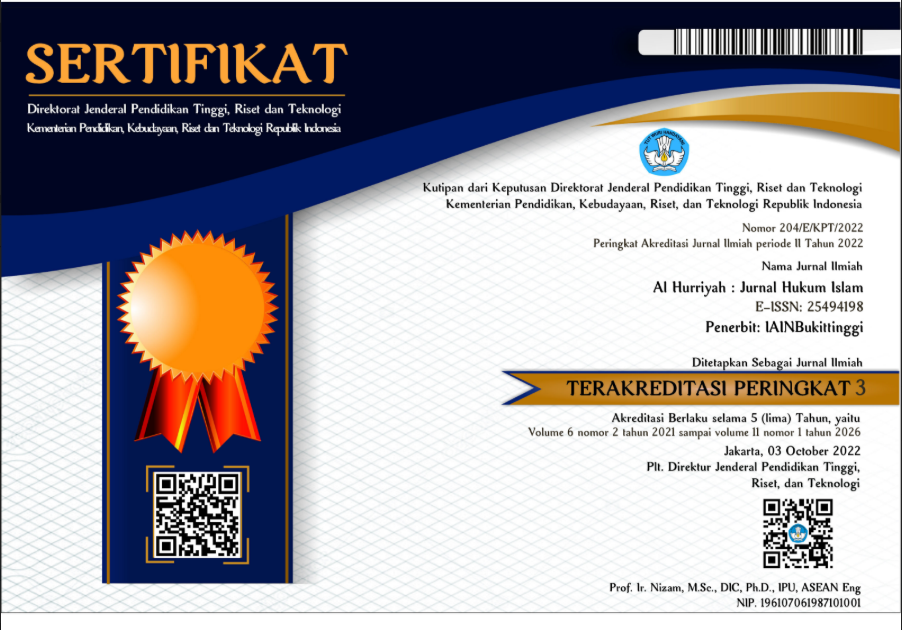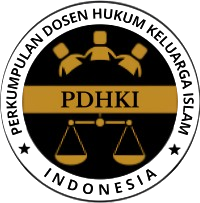Halal Certification Standards for Chicken Slaughter in Traditional Markets
DOI:
https://doi.org/10.30983/alhurriyah.v7i2.4474Keywords:
Slaughtering of broilers, MUI Fatwa number 12 of 2009,Abstract
Slaughter is a halal condition that can be consumed by land animals. That is, these animals are not halal without the slaughter process. Some broiler chicken owners still ignore the slaughtering process in accordance with Islamic sharia. This research is a field research, namely research conducted at the location that is the object of research, namely Cigasong Traditional Market, Majalengka Regency. In this research the method used is interview.From the research, it was concluded that: slaughtering by Rabani Slaughter House in the Cigasong traditional market, which was slaughtered by Mr. Lalan's employees, the slaughtering process was in accordance with MUI Fatwa number 12 of 2009 concerning Halal Slaughter Certification Certification Standards. Regarding slaughtering of slaughtered chickens, the implementation of slaughtering carried out at Rabani Chicken slaughterhouses in the Cigasong traditional market has all been met with Halal Slaughtering Certification Standards. Then it is suggested: The owner of the slaughterhouse at the Cigasong traditional market must pay attention and ensure the slaughter, For the Majalengka Ulema Council should pay regular visits to the place of broiler sellers in the Cigasong traditional market against Halal Slaughter Certification Standards. Is it already running, implemented and implemented by every owner of the Chicken House.
References
Abidin, Zainal, and Ibnu Mas’ud. “Fiqih Madzhab Syafi’i.†Bandung: Pustaka Setia, 2007.
Afrizal. Metode Penelitian Kualitatif: Sebuah Upaya Mendukung Penggunaan Penelitian Kualitatif Dalam Berbagai Disiplin Ilmu. PT RajaGrafindo Persada, 2014.
Amin, Ma’ruf. “Islam Menghalalkan Yang Baik Dan Mengharamkan Yang Buruk.†Jurnal Halal LPPOM MUI, no. 104 (2013): 28–297.
Anwar, Moch Khoirul. “Respon Pelaku Usaha Rumah Potong Ayam Terhadap Kewajiban Sertifikasi Halal.†Jurnal Hukum Ekonomi Syariah 3, no. 1 (2020): 27–39.
Arikunto, Suharsimi. “Prosedur Penelitian Kuantitatif Dan Kualitatif Dan R & D.†Bandung: Alfabeta, 2009.
Az-Zuhaili, Wahbah. Fiqih Islam Wa Adillatuhu, Terj. Abdul Hayyie Al-Kattani, Dkk, Jakarta: Gema Insani, 2011.
Cahyadi, Muh Nur. “Penerapan Sistem Jaminan Produk Halal Lppom-Mui Provinsi Sulawesi Selatan Terhadap Praktek Penyembelihan Di Pasar.†Jurnal Al-Qadau: Peradilan Dan Hukum Keluarga Islam 6, no. 2 (2019): 235–48.
Chairunnisyah, Sheilla. “Peran Majelis Ulama Indonesia Dalam Menerbitkan Sertifikat Halal Pada Produk Makanan Dan Kosmetika.†EduTech: Jurnal Ilmu Pendidikan Dan Ilmu Sosial 3, no. 2 (2017).
Djaelani, Aunu Rofiq. “Teknik Pengumpulan Data Dalam Penelitian Kualitatif.†Majalah Ilmiah Pawiyatan 20, no. 1 (2013): 82–92.
Fikriawan, Suad. “Sertifikasi Halal Di Indonesia (Analisis Kuasa Simbolik Dalam Kontestasi Fatwa Majelis Ulama Indonesia).†El-Barka: Journal of Islamic Economics and Business 1, no. 1 (2018): 27–52.
Harahap, Hanum. “Tinjauan Hukum Islam Tentang Stunning Pemotongan Hewan (Studi Pada Rumah Potong Hewan Di Desa Podomoro Kabupaten Pringsewu).†UIN Raden Intan Lampung, 2018.
Hidayat, Asep Syarifuddin, and Mustolih Siradj. “Sertifikasi Halal Dan Sertifikasi Non Halal Pada Produk Pangan Industri.†AHKAM: Jurnal Ilmu Syariah 15, no. 2 (2015).
Ilyas, Musyfikah. “Sertifikasi Dan Labelisasi Produk Halal Perspektif Maslahat.†Jurnal Al-Qadau: Peradilan Dan Hukum Keluarga Islam 4, no. 2 (2017): 357–76.
Irawan, Bambang. “Analisis Hukum Islam Terhadap Pelaksanaan Penyembelihan Ayam Di Pasar PON Kabupaten Jombang.†SHAKHSIYAH BURHANIYAH: Jurnal Penelitian Hukum Islam 1, no. 01 (2016).
Kaco, Suardi, and Nur Fitriana. “Praktik Penyembelihan Dan Pengolahan Ayam Di Rumah Potong Ayam Kecamatan Polewali (Tinjauan Undang-Undang Nomor 33 Tahun 2014 Tentang Jaminan Produk Halal).†J-Alif: Jurnal Penelitian Hukum Ekonomi Syariah Dan Budaya Islam 5, no. 2 (2020): 148–56.
Kartasudjana, Ruhyat, and E U Suprijatna. Ilmu Dasar Ternak Unggas. Penebar Swadaya. Jakarta, 2005.
Lalan. “Interview Pemilik Rumah Potong Ayam Rabani Pasar Cigasong Majalengka,†2019.
Mohammad, Mutiara Fajrin Maulidya. “The Pengaturan Sertifikasi Jaminan Produk Halal Di Indonesia.†Kertha Wicaksana 15, no. 2 (2021): 149–57.
Muamar, Afif, and Juju Jumena. “Standarisasi Halal Majelis Ulama Indonesia Dalam Penyembelihan Ayam Di Desa Kertawinangun Cirebon.†Al-Ahkam Jurnal Ilmu Syari’ah Dan Hukum 5, no. 1 (2020): 72–89.
Muttaqo, Lutfi Lut, Abdul Aziz, and Siti Zuhrotul Izza. “Praktik Penyembelihan Dan Pengolahan Ayam Di Rumah Potong Ayam (RPA) Desa Kajen Kecamatan Kajen Kabupaten Pekalongan.†El Hisbah: Journal of Islamic Economic Law 1, no. 2 (2021): 225–40.
Oni Syahroni. “Interview Eksekutor / Pemotong Ayam Di Rumah Patong Ayam Rabani,†2019.
“Penyembelihan Yang Sesuai Syari’at,†n.d.
Rahmaniati, Popi, and Dini Nur Hakiki. “Perancangan Sistem Jaminan Halal (Sjh) Di Rumah Potong Ayam Tpa Akbar Bandar Lampung.†International Journal Mathla’ul Anwar of Halal Issues 1, no. 2 (2021): 89–98.
Septiawan, Ade, and Ahmad Mukri Aji. “Kewenangan Lembaga Pengkajian Pangan, Obat-Obatan, Dan Kosmetika-Majelis Ulama Indonesia Pasca Berlakunya UU No. 33 Tahun 2014 Tentang Jaminan Produk Halal.†SALAM: Jurnal Sosial Dan Budaya Syar-I 3 (2016): 167–96.
Shohib, Muhammad. Departemen Agama RI, Al-Qur’an Dan Terjemahnya. Bogor: Syaamil Quran, 2007.
Sucipto, Sucipto, Riska Indra Wardani, Muhammad Arif Kamal, and Danang Triagus Setiyawan. “Analisis Teknoekonomi Alat Penyembelihan Ayam Untuk Mendukung Implementasi Sistem Jaminan Halal.†Jurnal Teknologi Industri Pertanian 30, no. 1 (2020).
Sugiono, Sugiono. Metode Penelitian Kuantitatif Kualitatif Dan R&D. CV. Alfabeta, Bandung, 2008.
Sulaiman, Anwar. “Interview Ketua MUI Kabupaten Majalengka,†2019.
Sunyoto, Danang. Analisis Regresi Dan Uji Hipotesis. Yogyakarta: Caps, 2011.
Utsaimin, M bin S Al. Tatacara Qurban Tuntunan Nabi. Jogjakarta: Media Hidayah, 2003.
Yusuf, Kadar M, Achmad Zirzis, and Siti Farida Nurlaili. Tafsir Ayat Ahkam: Tafsir Tematik Ayat-Ayat Hukum. Amzah, 2013.
Downloads
Published
How to Cite
Issue
Section
Citation Check
License
Authors who publish with this journal agree to the following terms:
- Authors retain copyright and grant the journal right of first publication with the work simultaneously licensed under a Creative Commons Attribution-ShareAlike 4.0 International License that allows others to share the work with an acknowledgment of the work's authorship and initial publication in this journal.
- Authors are able to enter into separate, additional contractual arrangements for the non-exclusive distribution of the journal's published version of the work (e.g., post it to an institutional repository or publish it in a book), with an acknowledgment of its initial publication in this journal.
- Authors are permitted and encouraged to post their work online (e.g., in institutional repositories or on their website) prior to and during the submission process, as it can lead to productive exchanges, as well as earlier and greater citation of published work (See The Effect of Open Access).





